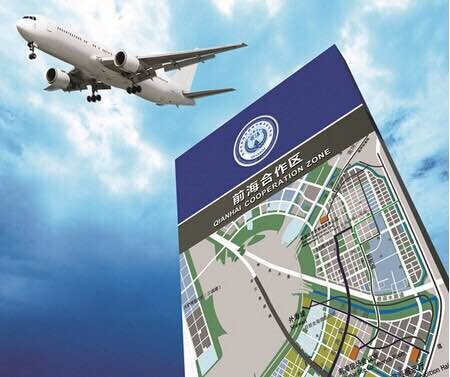|
Spotlight: Qianhai Shenzhen-Hong Kong Modern Service
Industry Cooperation Zone
Posted
on September
25, 2014 by China Briefing
|

Now no-matter foreign compnay or domestic company,
it is a trend to develop business in Qianhai. JS assists clients in every step
to start business and support them to enlarge the market. Please contact us in
following way if you have any query:
Flint Hong
Senior Manger
E-mail: consultant@jisitop.com
|
Officially
approved by China’s State Council on August 26, 2010, the Qianhai Shenzhen-Hong
Kong Modern Service Industry Cooperation Zone (Qianhai) was established with
the aim of serving as an experimental business zone for better interaction
between Mainland China and Hong Kong in the financial, logistics, and IT
services sectors. The zone, which is still in the process of setting up, covers
15 km2 and provides various incentives and preferential finance policies for
foreign investment.
Overview
By the
end of April 2014, a total of 6,470 companies with a combined registered
capital of RMB 450 billion had already registered in the zone. Major industries
in the zone include:
• Financial
and information services
• Modern
logistics
• Technology
• Cultural
and creative industries
• Professional
services
Finance,
the dominant sector in the zone, constitutes over 60 percent of resident
enterprises such as HSBC, Hang Seng Bank and Standard Chartered.
The
Qianhai Bay Bonded Port Area, set up
inside the zone to liberalize services trade between Hong Kong and Guangdong,
includes seven warehouses and provides services such as international
procurement, selling and distribution, international transit, R&D, and
processing and manufacturing. Also, the China Securities Regulatory Commission
(CSRC) has established an operational office in Qianhai, overseeing the
management of financial institutions and the implementation of preferential
policies.
Preferential
Tax Policies for Select Industries
Qianhai
provides preferential tax policies for select industries, including:
• Technology
Service Enterprises
1. Hi-tech enterprises, integrated circuit
enterprises and software and IC enterprises are exempt from corporate income
tax (CIT) for two years starting from their first profitable year and taxed at
a half-rate for the following three years.
2. Technology transfers are granted a
preferential tax reduction.
• Environmentally
Friendly Enterprises
1. Investments in energy- and
water-conservation equipment are tax deductible.
2. Enterprises engaging in environmental
protection projects such as energy- and water-conservation are exempt from CIT
for the first two years and taxed at a half-rate for the following three years.
• Technical
Innovation Enterprises
1. R&D investments in new technologies,
products and processing are tax deductible.
2. Animation enterprises are exempt from CIT
for the first two years of operations and taxed at a half-rate for the
following three years.
• Financial
Services Industry
1. Preferential policies are provided to
promote the development of securities and investment funds.
2. Preferential CIT policies are provided to
Qualified Foreign Institutional Investors (QFII).
3. Venture Capital (VC) enterprises that make
equity contributions to small and medium-sized enterprises (SMEs) for over two
years are eligible for tax reductions.
Other
Preferential Tax Policies
Qianhai
also provides enterprises with special tax policies such as reduced CIT and
individual income tax (IIT) rates. Details of these preferential tax policies
can be found below.
Preferential
CIT Policies
According
to “Announcement No.26 [2014]” released by the Ministry of Finance (MOF),
enterprises engaging in the types of businesses encouraged in the “Catalog for
Preferential Tax Policies List” will be taxed at a reduced CIT rate of 15
percent starting on January 1, 2014 until December 31, 2020. The Catalog mainly
includes four industrial sectors, namely technology services, modern logistics,
the cultural and creative industry and information services. The following
conditions must be met for enterprises to enjoy the preferential rate:
• The
enterprise must be engaged in business activities categorized as eligible in
the Preferential Catalog;
• The
income of these business activities should account for more than 70 percent of
the enterprises’ total income, which itself can only include income from the
company’s primary business activities;
• In
the case that a company has branches or representative offices (RO) both inside
and outside the zone, the reduced 15 percent CIT rate shall only apply to the
branches and ROs located within the zone.
It
should also be noted that if enterprises are eligible for both the CIT rate of
15 percent as stated in the Catalog as well as other preferential treatments in
accordance with CIT law, they can simultaneously enjoy multiple such benefits.
Also, the “taxed at a half-rate” policy only applies based on a 25 percent CIT
rate.
Preferential
IIT Policies
According
to the “Circular on Financial Subsidies for Individual Income Tax on Foreign
High-end Talent and Talent in Short Supply in the Qianhai Zone (Shen Fu [2012]
No. 143),” foreign high-end talent engaged in encouraged industries in the
Qianhai Zone are eligible for IIT reductions. Financial Subsidies will be
provided by the Shenzhen municipal government if the amount of IIT income paid
by the foreign talent on his/her salary exceeds 15 percent of his/her total
taxable salary income.
Preferential
BT Policies
Starting
on August 1, 2014, factoring service enterprises established in Qianhai,
Shenzhen are included in a preferential business tax (BT) program. A factoring
enterprise’s income generated through interest shall be taxed based on the
difference between the obtained interest and the interest paid to financial
institutions (such as banks). Other income gained from factoring shall be taxed
on the full amount.
Preferential
Stamp-tax Policies
Contracts
signed for outsourcing activities between companies within a corporate group
are regarded as agency appointment contracts and shall be exempt from
stamp-tax.
Furthermore,
tax declaration procedures have been substantially simplified in the zone,
enabling taxpayers to complete their tax declarations within only 10 minutes.
|